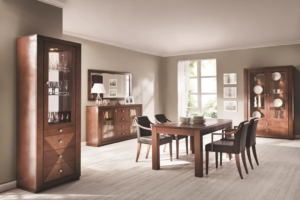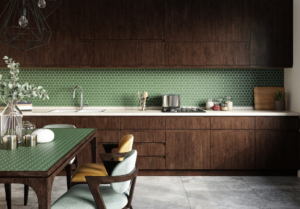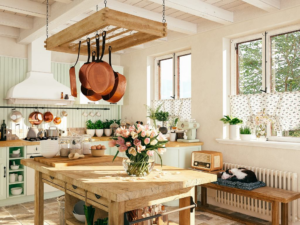Living in harmony with nature

BIOMIMETICS is the imitation of nature, the use of natural techniques, structures, and processes from the natural environment. It is a scientific discipline, years of research and testing, and ingenious discoveries whose prototype was Velcro (the one from the dog’s tail), whose properties were used to produce the fastening method popular today.
However, imitating nature and being inspired by its functioning can be implemented in the arrangement of our homerooms without such scientific preparations. What for? To create interiors that harmonize with our needs, are ergonomically arranged, functional and beautiful in their appearance.
HARMONY
In nature, all elements of the ecosystem live in perfect proportions, in full symbiosis and this ideal balance is disturbed only by … humans. Without entering into ecological polemics, but concentrating solely on the aesthetics of the home interior, be inspired by this natural sense of balance and harmony, introducing order and proportion into your furnishings. How?
By hanging artwork on the wall to balance an overly empty wall against a large piece of furniture on the opposite wall.
By placing a floor lamp next to an armchair to create a tandem that works well together.
Don’t have the dining table next to the breakfast nook in the kitchen, as two tables next to each other in the same space would be a misunderstanding.
By using different accessories, materials, textures, or colors, you will compose your ecosystem according to your inner nature.
Harmony is a sense of balance and proportion. Being wary of overdoing it, of excess, and not falling into minimalism that is too impoverishing.
LIGHTING
Light is an essential host for nature. In the home, too, it is necessary for life, both in the form of sunlight, which you invite through windows into the interior, and artificial lighting, which you use for functional needs. Recent research confirms that if our body is in sync with the sun’s cycle – we have better results in our daily existence. How?
By imitating the behavior of leaves and flowers, depending on the movement of the sun, you can similarly regulate the access of light to our interior.
You can leave south-facing windows uncovered in winter to make it easier for the sun’s rays to warm the room.
In summer, installing blinds will reduce the excessive temperature and create the necessary shade at this time of year.
In dark and small rooms, increase the number of lamps to help you light up space as needed.
In the bedroom, install light bulbs with subtle colors and a diffused light character, and you can paint the walls in dark, muted colors for better sleep and rest.
Plenty of light in the living area of your home in the form of numerous lamps and varied lighting scenes reduces the feeling of depression (which increases especially in the winter months), stimulates action, increases the level of serotonin responsible for feelings of happiness. So it’s probably worth adding a light bulb somewhere?
FUNCTIONALITY
In nature, organisms adapt their shapes to their functions: the giraffe has a long neck to eat leaves from high branches, the chameleon changes color to camouflage itself against nature and elephants have a trunk to eat, drink and bathe. How does this relate to interior design? Well, to choose furniture that functionally suits you and your needs. Because what would a giraffe’s trunk be good for?
Choose a comfortable sofa instead of a representative piece of furniture if relaxation is important to you and you don’t have a lavish palace where representative functions are a priority.
Adjust the size of the dining table to the number of family members and the functions it has to perform on a daily basis.
Choose the height of the bed according to your health predispositions, and the height of the kitchen worktop according to your height.
Install the TV at an appropriate height, depending on whether you watch it sitting on a chair, sofa, or lying in bed.
Ergonomically planned space is great for the sense of flow, or freedom of being. Furniture is meant to serve your needs, not you adjusting your daily life to its setting.
BEAUTY
In nature, beauty matters. The colors of butterflies, birds, flowers, and the scent of sweet nectar attracting insects.
The same has value in our living spaces. By surrounding yourself with what is beautiful to you – you increase your sense of happiness and the simple joy of existence, and your mind relaxes as you strain your eyes with what is attractive to you.
If you love reading and are a bookworm – make a library wall. Its appeal will have more visual value for you than for a DVD movie enthusiast.
You love the colors and scent of flowers – surround yourself with them, and remember to replenish your vases with seasonal plants.
You love softness and warmth – you should have plenty of cushions, blankets, and structures to wrap yourself in, rather than organizing a minimalist sterile and empty interior.
If you are sentimental about the summer season – leave seashells on the shelf in the bathroom, and if you love winter – leave lights on dried birch branches.
There is beauty in you and if you pay attention to it in your everyday life, you will live more pleasantly, happily, and in harmony with yourself.





